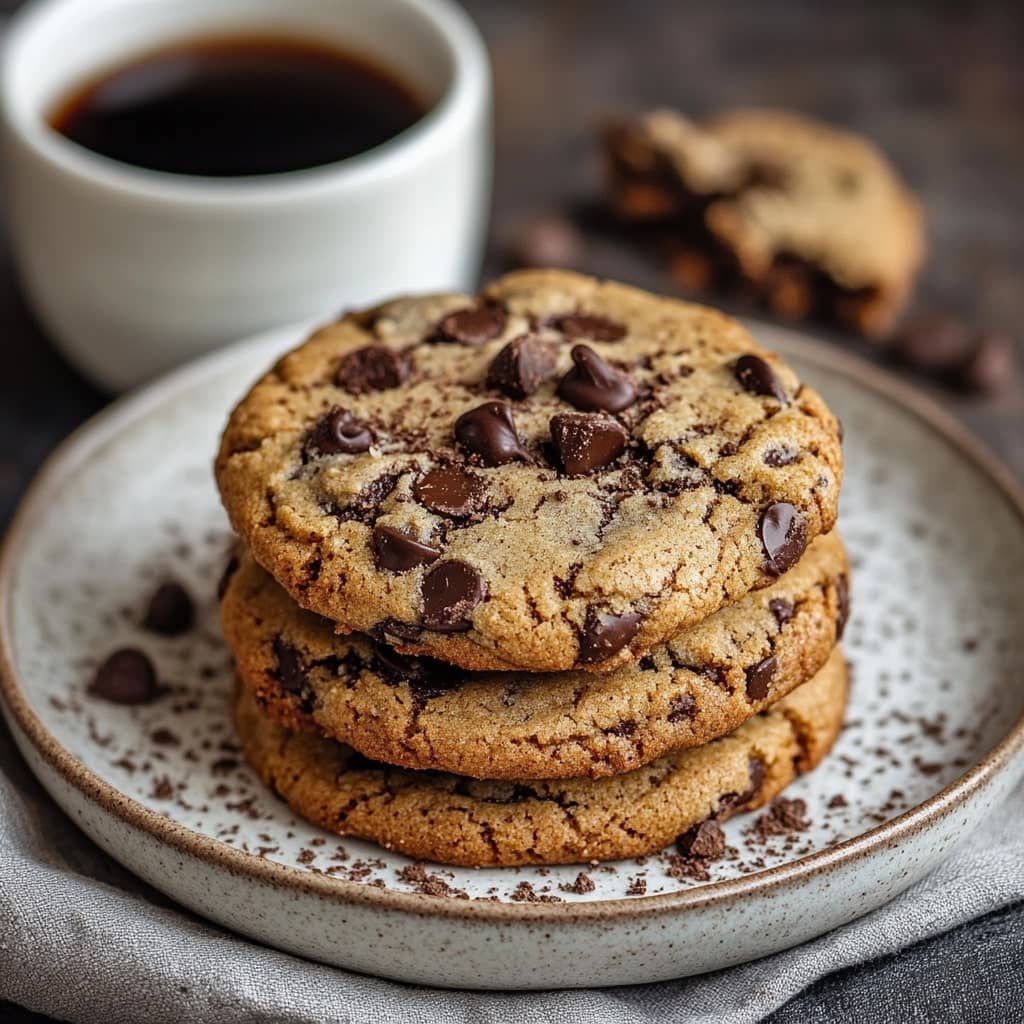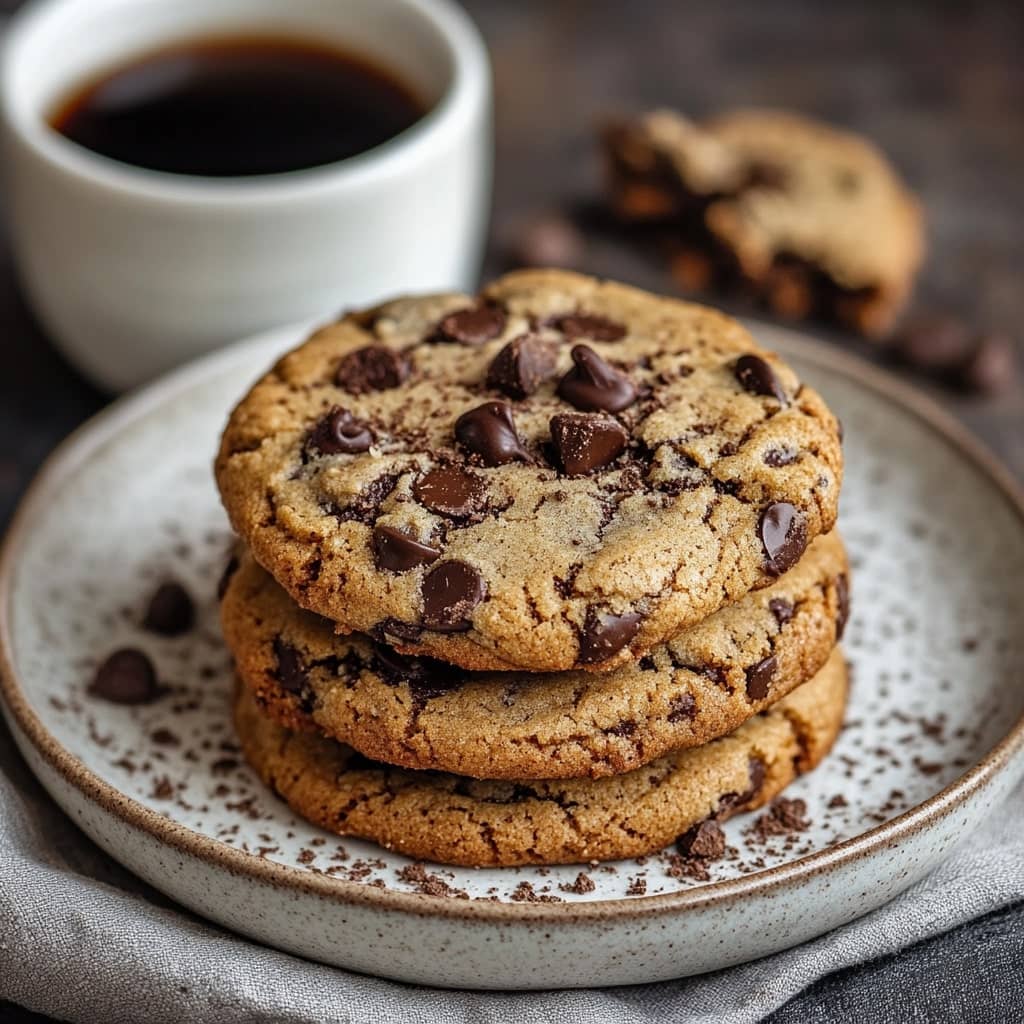The combination of coffee and chocolate is a classic pairing, loved by many for its rich, deep flavor. Espresso chocolate chip cookies take this beloved combination and elevate the traditional chocolate chip cookie by infusing it with bold espresso, offering a treat that’s both familiar and delightfully different. These cookies are perfect for coffee lovers and dessert enthusiasts alike, bringing a subtle bitterness that balances the sweetness of the chocolate. The cookie itself retains that soft, chewy texture with slightly crispy edges that make for an irresistible bite. Whether enjoyed as an afternoon pick-me-up, a sweet snack, or a unique addition to your dessert tray, espresso chocolate chip cookies are a sophisticated twist on a classic favorite.
The history of chocolate chip cookies dates back to the 1930s, when Ruth Wakefield of the Toll House Inn in Massachusetts added chunks of Nestlé semi-sweet chocolate to her cookie dough, creating what would become one of the most iconic American desserts. Since then, the cookie has seen countless variations, including the addition of nuts, different types of chocolate, and even ingredients like oats and coconut. The incorporation of espresso or coffee into baked goods has its own tradition, commonly found in tiramisu and mocha cakes. Combining espresso with chocolate chip cookies is a relatively modern innovation, born from the specialty coffee movement and the growing popularity of gourmet home baking. This pairing reflects contemporary tastes, where depth and complexity of flavor are appreciated even in simple treats.
Ingredients Breakdown: The essential ingredients for espresso chocolate chip cookies include all-purpose flour, which forms the structure of the cookie, and unsalted butter, which contributes to the cookie’s richness and tender texture. Brown sugar and granulated sugar are used in tandem—brown sugar adds moisture and a caramel note due to its molasses content, while granulated sugar contributes to the cookie’s crispness and spread. Eggs provide binding and structure, while vanilla extract enhances the overall flavor. Baking soda acts as a leavening agent, ensuring the cookies have the right rise and texture. The standout ingredients—espresso powder and semi-sweet chocolate chips—bring depth and contrast. Espresso powder, made from ground, brewed, and dehydrated coffee beans, gives a strong coffee flavor without additional liquid. The semi-sweet chocolate chips offer a rich sweetness that balances the bitter tones of espresso. A pinch of salt enhances all the flavors and balances sweetness.
Step-by-Step Recipe: 1. Preheat your oven to 350°F (175°C) and line two baking sheets with parchment paper. This ensures even baking and prevents sticking. 2. Cream together 1 cup of unsalted butter, ¾ cup brown sugar, and ½ cup granulated sugar in a large bowl until light and fluffy—about 3-4 minutes with a mixer. This process incorporates air and ensures a tender cookie. 3. Add 2 large eggs and 2 teaspoons of vanilla extract to the butter-sugar mixture and beat until well combined. 4. In a separate bowl, whisk together 2¼ cups of all-purpose flour, 1 teaspoon baking soda, 1 teaspoon salt, and 1½ tablespoons of espresso powder. Mixing the dry ingredients separately ensures even distribution. 5. Gradually add the dry ingredients to the wet ingredients, mixing just until combined to avoid overworking the dough. 6. Stir in 2 cups of semi-sweet chocolate chips with a spatula or wooden spoon. For a more intense chocolate experience, you can add chopped dark chocolate instead. 7. Use a cookie scoop or tablespoon to drop dough balls onto the prepared baking sheets, spacing them about 2 inches apart. 8. Bake for 10-12 minutes, or until the edges are golden brown and the centers look just set. 9. Allow cookies to cool on the baking sheet for 5 minutes, then transfer to a wire rack to cool completely.
Tips for the Perfect Cookie: Use room-temperature ingredients to ensure even mixing. Don’t overmix the dough after adding the flour, as this can lead to tough cookies. Chill the dough for at least 30 minutes before baking if you prefer a thicker cookie with less spread. For an enhanced flavor, toast the flour in a skillet for a few minutes to bring out a nutty, complex aroma. Sprinkle a pinch of flaky sea salt on top of the cookies right after baking to intensify the sweet-salty flavor contrast. Make sure to use high-quality espresso powder and chocolate chips, as these are the stars of the cookie. Always allow cookies to cool fully to let the flavors develop and to achieve the best texture.
Variations and Customizations: You can easily modify the basic recipe to suit your taste or dietary needs. For a nutty twist, add ½ cup of chopped walnuts, pecans, or hazelnuts to the dough. For a mocha-inspired version, drizzle cooled cookies with a chocolate-coffee glaze. To create a sandwich cookie, fill two cookies with espresso buttercream or mascarpone cream. Use white or dark chocolate chips instead of semi-sweet, or mix different types of chocolate for a more complex flavor. For a gluten-free version, use a 1:1 gluten-free baking flour blend. Vegan bakers can substitute the butter with plant-based butter and use flax eggs in place of regular eggs. Add a teaspoon of cinnamon or a pinch of cayenne for a subtle spicy note. For a more pronounced espresso flavor, double the espresso powder or add a shot of brewed espresso to the dough (adjust the flour slightly to account for added liquid).
Health Considerations and Nutritional Value: Espresso chocolate chip cookies, while delicious, are still a treat and should be enjoyed in moderation. Each cookie contains a mix of carbohydrates, fats, and sugars, primarily from the flour, butter, and sugar content. The presence of espresso powder adds a small amount of caffeine, making them unsuitable for young children or caffeine-sensitive individuals. On average, one cookie can contain between 150-200 calories, with around 8-10 grams of fat and 15-20 grams of carbohydrates. Using dark chocolate can provide a small boost of antioxidants, and you can reduce the sugar slightly without compromising flavor. For a healthier version, try substituting some of the flour with whole wheat flour and replace half the butter with applesauce or Greek yogurt. Coconut sugar or maple syrup can be used in place of white sugar for a lower glycemic index option. Adding chia seeds, flax meal, or oats can increase fiber content and make the cookies slightly more nutritious.
FAQ:
Q: Can I use brewed coffee instead of espresso powder? A: Brewed coffee adds liquid, which can alter the texture. It’s better to use instant espresso powder for a concentrated flavor without changing the dough’s consistency.
Q: How should I store these cookies? A: Store them in an airtight container at room temperature for up to 5 days, or freeze for up to 3 months.
Q: Can I make the dough ahead of time? A: Yes, the dough can be refrigerated for up to 72 hours or frozen in scoops for convenient baking.
Q: What’s the best type of chocolate to use? A: Semi-sweet or dark chocolate chips are recommended, but chopped chocolate bars offer a more rustic, melty texture.
Q: Are these cookies caffeinated? A: Yes, they contain a small amount of caffeine from the espresso powder—approximately 5-10 mg per cookie.
Q: Can I make these cookies chewy or crispy? A: For chewy cookies, bake for the shorter end of the time range and store with a slice of bread. For crispier cookies, bake a bit longer and allow to cool fully.
Q: What if I don’t have espresso powder? A: You can substitute with instant coffee granules, though the flavor may be less intense.

Espresso Chocolate Chip Cookies
Ingredients
Method
- Sure! Here’s the rewritten version of your recipe instructions, keeping all the same content but with a smoother flow and consistent tone:
- In a stainless steel saucepan, melt the butter over medium heat, cooking until the milk solids at the bottom turn a deep amber brown—this usually takes about 10 minutes. Once browned, pour all of the butter, including the browned bits, into a mixing bowl.
- 14 tablespoons (196 g) unsalted butter
- Stir in the ground espresso until evenly combined, then set the bowl aside to cool to room temperature. In most kitchens, this cooling process takes around 20 to 30 minutes.
- 1 tablespoon ground espresso
- Once the mixture has cooled, whisk in the light brown sugar and granulated sugar for about 1 minute, or until fully combined and smooth.
- ½ cup + 2 tablespoons (128 g) light brown sugar, ½ cup (100 g) granulated sugar
- Next, whisk in the egg, egg yolk, and vanilla extract until the mixture is glossy and emulsified.
- 1 large egg (54 g), 1 large egg yolk (18 g), 2 teaspoons vanilla extract
- Using a spatula or wooden spoon, fold in the flour, baking soda, salt, and chopped chocolate or mini chips until just combined—be careful not to overmix.
- 1⅔ cups + 1 tablespoon (212 g) all-purpose flour, 1 teaspoon baking soda, 1 teaspoon salt, ¾ cup (76 g) chopped semi-sweet chocolate or mini chocolate chips
- Scoop the cookie dough onto a parchment-lined baking sheet. Place the entire tray in the freezer to chill for at least 3 to 4 hours—overnight is ideal for maximum flavor and texture development.
- When you’re ready to bake, preheat your oven to 350°F (180°C). Arrange the frozen cookie dough balls on a baking sheet, spacing them at least 2 inches apart. Bake for 10 to 12 minutes, or until the edges are golden brown and the centers remain pale and slightly puffy.
